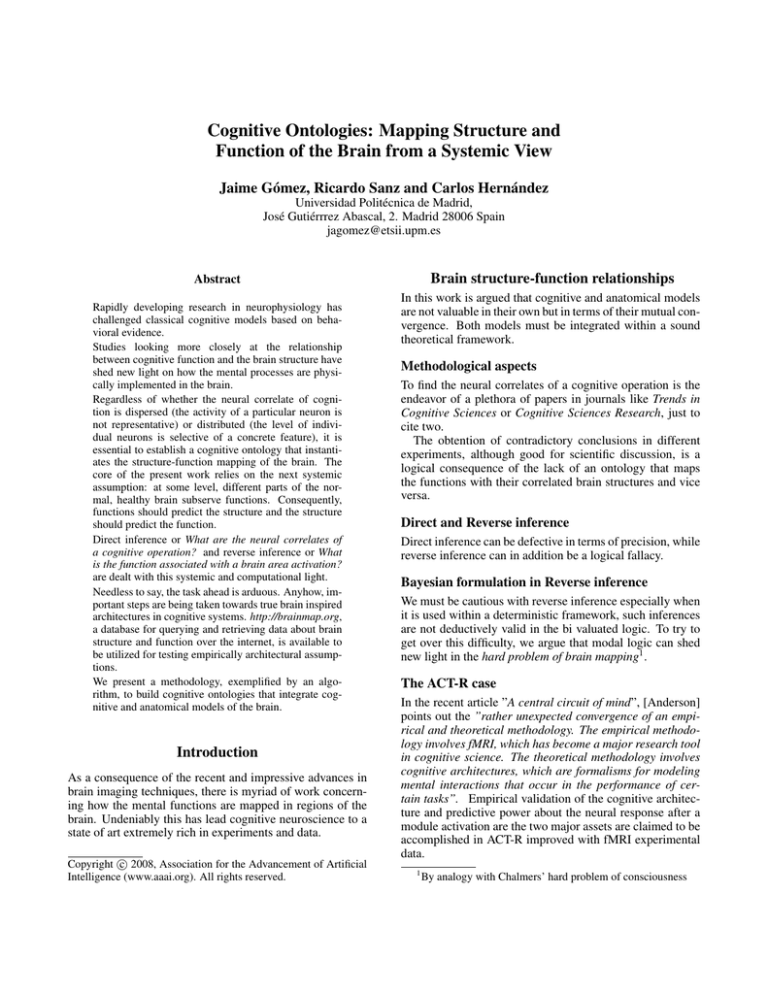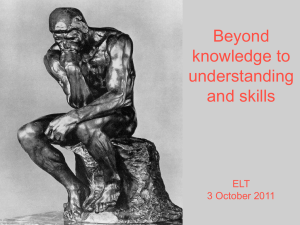
Cognitive Ontologies: Mapping Structure and
Function of the Brain from a Systemic View
Jaime Gómez, Ricardo Sanz and Carlos Hernández
Universidad Politécnica de Madrid,
José Gutiérrrez Abascal, 2. Madrid 28006 Spain
jagomez@etsii.upm.es
Brain structure-function relationships
Abstract
Rapidly developing research in neurophysiology has
challenged classical cognitive models based on behavioral evidence.
Studies looking more closely at the relationship
between cognitive function and the brain structure have
shed new light on how the mental processes are physically implemented in the brain.
Regardless of whether the neural correlate of cognition is dispersed (the activity of a particular neuron is
not representative) or distributed (the level of individual neurons is selective of a concrete feature), it is
essential to establish a cognitive ontology that instantiates the structure-function mapping of the brain. The
core of the present work relies on the next systemic
assumption: at some level, different parts of the normal, healthy brain subserve functions. Consequently,
functions should predict the structure and the structure
should predict the function.
Direct inference or What are the neural correlates of
a cognitive operation? and reverse inference or What
is the function associated with a brain area activation?
are dealt with this systemic and computational light.
Needless to say, the task ahead is arduous. Anyhow, important steps are being taken towards true brain inspired
architectures in cognitive systems. http://brainmap.org,
a database for querying and retrieving data about brain
structure and function over the internet, is available to
be utilized for testing empirically architectural assumptions.
We present a methodology, exemplified by an algorithm, to build cognitive ontologies that integrate cognitive and anatomical models of the brain.
Introduction
As a consequence of the recent and impressive advances in
brain imaging techniques, there is myriad of work concerning how the mental functions are mapped in regions of the
brain. Undeniably this has lead cognitive neuroscience to a
state of art extremely rich in experiments and data.
c 2008, Association for the Advancement of Artificial
Copyright Intelligence (www.aaai.org). All rights reserved.
In this work is argued that cognitive and anatomical models
are not valuable in their own but in terms of their mutual convergence. Both models must be integrated within a sound
theoretical framework.
Methodological aspects
To find the neural correlates of a cognitive operation is the
endeavor of a plethora of papers in journals like Trends in
Cognitive Sciences or Cognitive Sciences Research, just to
cite two.
The obtention of contradictory conclusions in different
experiments, although good for scientific discussion, is a
logical consequence of the lack of an ontology that maps
the functions with their correlated brain structures and vice
versa.
Direct and Reverse inference
Direct inference can be defective in terms of precision, while
reverse inference can in addition be a logical fallacy.
Bayesian formulation in Reverse inference
We must be cautious with reverse inference especially when
it is used within a deterministic framework, such inferences
are not deductively valid in the bi valuated logic. To try to
get over this difficulty, we argue that modal logic can shed
new light in the hard problem of brain mapping1 .
The ACT-R case
In the recent article ”A central circuit of mind”, [Anderson]
points out the ”rather unexpected convergence of an empirical and theoretical methodology. The empirical methodology involves fMRI, which has become a major research tool
in cognitive science. The theoretical methodology involves
cognitive architectures, which are formalisms for modeling
mental interactions that occur in the performance of certain tasks”. Empirical validation of the cognitive architecture and predictive power about the neural response after a
module activation are the two major assets are claimed to be
accomplished in ACT-R improved with fMRI experimental
data.
1
By analogy with Chalmers’ hard problem of consciousness
stimuli:
words
novel objects
AM
task level
Reading
V2 is necessary for AM
Manipulation
PCOB
AM causes activates V5
function domain
cognitive
function level
visual
word form
processing
action
retrieval
structure domain
V2 is necessary for POCB
AM causes activates V2
V2
V5
LPLF area
effective connection V2 V5
anatomical level
motor
frontal
occipital
temporal
occipitalparietal
Figure 1: Cognitive ontology at functional and anatomical
levels. In single line the causal link for visual word form
processing and in double line for action retrieval
Figure 2: V2 area is necessary for both processing the contour of objects from the background (PCOB) and attending
to motion in a visual stimulus (AM). Attending to motion
AM, causes activation of areas V2 and V5, thus it increases
the effective connectivity of areas V2 and V5
An algorithm for the cognitive ontology
building process
Empirical validation Brain imaging studies like fMRI, can
provide empirical evidence for the theoretical architectural assumption. Accordingly, the model proposed is falsifiable and prone to be updated and modified based on
the divergencies with the empirical results.
Explicability and Prediction BOLD response in a brain
region can be predicted from time coarse of modules in
ACT-R.
The cognitive ontology building process
Typically, brain imaging studies aim to find the spatial and
(ideally) temporal pattern of brain activity that underlie the
unique condition of function activation at any particular
level. In short, a cognitive ontology must be able to predict
the engaged function from anatomical activation and conversely, the anatomical activation necessary for the function
triggering. This methodology of ontology building, assumes
that both approaches top-down and bottom up are complementary. The top-down is the function-structure link causes
activation and the the bottom is the structure-function link
necessary for.
As illustrated in Figure 1, the stimuli and the tasks are the
conditions under which the areas are activated.
In the cognitive ontology drawn in Figure 2, we discern
three relationships, two are structure-function type (RN,CA)
and one is structure-structure (EC).
Relation necessary for It comes up from functional imaging experiments measured by neurophysiologists
Relation causes activation It is inferred from structural
lesions in the brain and is studied by psychologists
Relation effective connectivity Functional interactions of
anatomical areas. They are inferred from coactivation in
these different brain areas.
We propose an algorithm for the ontology building process.
We sketch briefly, for limitations of space, some main concepts of modal logic that are going to be used in the algorithm.
The aim of the algorithm is to obtain an ontology at
the simplest possible level. As a consequence of the iterative process implemented by the algorithm, the relationship
between the functions and structures in the ontology converge. In short, the mapping function structure at the end
will be 1:1.





